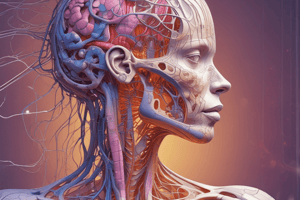Podcast
Questions and Answers
Which part of the body is primarily responsible for activating the Autonomic Nervous System?
Which part of the body is primarily responsible for activating the Autonomic Nervous System?
- Cerebral cortex (correct)
- Brain stem (correct)
- Spinal cord (correct)
- Hypothalamus (correct)
The Autonomic Nervous System operates primarily via voluntary reflexes.
The Autonomic Nervous System operates primarily via voluntary reflexes.
False (B)
What are the two major subdivisions of the Autonomic Nervous System?
What are the two major subdivisions of the Autonomic Nervous System?
Sympathetic nervous system and Parasympathetic nervous system
Which of the following is a function controlled by the Autonomic Nervous System?
Which of the following is a function controlled by the Autonomic Nervous System?
What is the primary function of the adrenal medulla?
What is the primary function of the adrenal medulla?
The _____ contains the principal types of acetylcholine receptors.
The _____ contains the principal types of acetylcholine receptors.
Flashcards are hidden until you start studying
Study Notes
Learning Objectives
- Understand the organization and function of the Autonomic Nervous System (ANS).
- Recognize the differences and similarities between the sympathetic and parasympathetic systems.
The Autonomic Nervous System
- ANS mainly activated by centers in multiple regions: spinal cord, brain stem, hypothalamus, and portions of the limbic system.
- Operates through visceral reflexes, which are subconscious sensory signals from visceral organs that influence autonomic control.
- Involuntary reflexes are essential for gastrointestinal (GI) and urinary functions.
General Organization of the Autonomic Nervous System
- Composed of two major subdivisions:
- Sympathetic nervous system
- Parasympathetic nervous system
- Efferent autonomic signals control visceral functions, including:
- Arterial pressure
- GI motility and secretion
- Urinary bladder emptying
- Sweating
- Body temperature regulation
- Metabolic rate management
Physiologic Anatomy of the Sympathetic Nervous System
- Comprised of preganglionic and postganglionic neurons.
- Receptors on effector organs, including two principal types of acetylcholine receptors, influence autonomic reactions.
- Adrenergic receptors categorized as alpha and beta, mediating excitatory or inhibitory actions.
Physiologic Anatomy of the Parasympathetic Nervous System
- Functions to conserve energy and influence rest-and-digest processes.
- Engages with regulatory pathways distinct from sympathetic activation.
Mechanisms of Transmitter Secretion and Removal
- Action occurs at postganglionic endings, critical for the termination of autonomic signaling.
Function of the Adrenal Medulla
- Works in conjunction with the sympathetic nervous system.
- Stimulus rate correlates to both sympathetic and parasympathetic effects; important for understanding stress responses.
Control and Coordination of the Autonomic Nervous System
- Managed through medullary, pontine, and mesencephalic processes that facilitate integrative functions of the ANS.
- "Mass discharge" enables rapid and selective stimulation of target organs for immediate bodily responses.
Studying That Suits You
Use AI to generate personalized quizzes and flashcards to suit your learning preferences.




